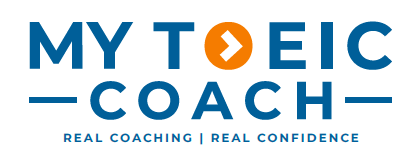TOEIC Listening Part 3: Mastering Conversations
Part 3 can feel like it’s moving at double speed — multiple voices, changing topics, and only one chance to hear it. But once you know where to focus and what to ignore, it becomes a section where you can score big.
🎯 What Part 3 Tests
In this section, you’ll hear 13 short conversations, each followed by three multiple-choice questions (39 questions total).
The topics feel real — workplace updates, travel changes, shopping exchanges, meetings, and service situations.
Questions appear on-screen or in your booklet as you listen. Expect American, British, Australian, and Canadian accents.
👥 Two vs. Three Speakers
Two speakers (most common): manager & employee, receptionist & customer, colleagues.
Three speakers (added in 2018): meetings, conference calls, group planning.
Pro tip: In three-person conversations, the third voice might only speak once — but that single line can hold the answer. Never tune them out.
📝 Question Types You’ll Face
Each conversation can test:
Details — time, location, decision made.
Purpose — why they’re talking or meeting.
Next steps — what someone will probably do.
Attitude — how a speaker feels or reacts.
Function — what a phrase means in context.
Visual link — connecting the audio to a chart, schedule, or sign.
⚠️ Common Challenges
Not enough time to read all 3 questions before audio starts.
Struggling to track 3 different voices.
Many answers are implied, not directly stated.
Distractors repeat audio keywords but twist the meaning.
Accents and casual speech cause hesitation.
🛠️ Winning Strategy
Scan Question 1 fast before audio starts.
Identify roles — who’s leading, who’s asking, who’s reacting.
Listen for changes — delays, reschedules, new plans.
If there’s a visual, glance before listening.
Use logic — “Let’s reschedule” means the meeting is postponed.
Eliminate mismatches in tone, tense, or purpose.
Move on quickly — don’t chase lost details.
🚫 Traps to Avoid
Picking an answer just because it repeats a word you heard.
Ignoring the “quiet” speaker — they might deliver the key fact.
Misreading intent phrases — “I’ll handle that” is a promise, not past action.
Getting distracted by numbers or names that don’t matter.
Assuming the last sentence always hides the answer — it doesn’t.
Final Word
Part 3 rewards preparation. The more you practise identifying speaker roles, catching changes, and linking information to visuals, the more this section turns from chaos into control.
For more strategies and resources to boost your TOEIC conversation skills, visit the English Library Collection and start mastering Part 3 with confidence.

